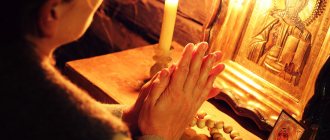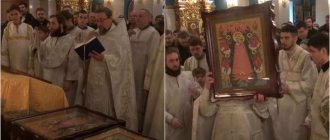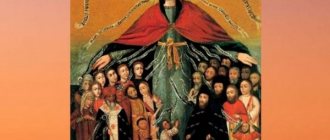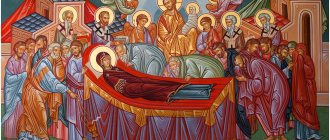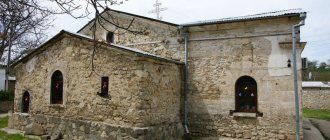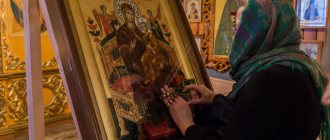What is prayer?
The Orthodox Church teaches that in order to receive God's gracious help, it is necessary to be in continuous communion with the Lord. This dialogue is achieved through prayer. However, the widely known text “The Dream of the Virgin Mary” is not actually an Orthodox prayer.
Prayer can be divided into two types. Canonical, church prayer - prayer texts introduced by the Church into the canon - the rule - are used. And the “creative”, personal “conversation” of every Christian with God in his own words. Both types of prayer communication are important for a full spiritual life.
Theotokos at the crucified Christ (Crucifixion in an Orthodox church)
Saint Theophan the Recluse (1815-1894) wrote: “You cannot say “pray yourself” the first time; a person cannot do this, just as, for example, someone who has not studied it cannot speak French. And you need to learn prayer. It is necessary to acquire the skill of prayerful turns of thought and movements of feelings from the prayers of others, just as one learns foreign languages from printed conversations. For this purpose, we have prayer books for home use and perform prayer rites in church services. It is through them that one must first become accustomed to prayer.”
Canonical prayer
Any Orthodox prayer book contains many canonical (correct, proven) prayers.
“We have a rich selection of prayers that were suffered by ascetics of the faith and born in them by the Holy Spirit... It is important to find and know a sufficient number of them in order to find the appropriate prayers at the right time. The point is to learn by heart a sufficient number of significant passages from the psalms or from the prayers of the saints; Each of us is more sensitive to one passage or another. Mark for yourself those passages that touch you deeply, that are meaningful to you, that express something. About sin, or about bliss in God, or about struggle, which you already know from experience.
Memorize these passages. Because some day, when you are so discouraged, so deep in despair that you cannot evoke anything personal, no personal words in your soul, you will find that these passages will float to the surface and appear to you as a gift from God, as a gift to the Church, as a gift of holiness, replenishing the decline of our strength. Then we really need the prayers that we have memorized so that they have become a part of ourselves” (book “Learn to Pray!” by Metropolitan Anthony of Sourozh, 1914-2003).
FAQ
Can reading a prayer harm me in some way?
No, sincere faith has never harmed anyone.
What happens if I violate the ritual of reading the prayer or do not do it regularly?
Most likely, you will not get the expected effect or the time interval, its occurrence will increase significantly.
How soon will I get what I want?
It is difficult to answer this question, since a lot depends on each specific situation, as well as on the degree of your participation in resolving the problem.
The importance of personal prayer for every believer
For every Christian, personal prayer, coming from the very heart of the person praying, is of great importance. Archpriest Andrei Tkachev gives this advice:
“You need to read texts from the Prayer Book, penetrate their meaning, but from time to time move on to personal prayer. Accelerate along the runway - warm up using the Prayer Book. And then take to the air yourself. From time to time, putting the Prayer Book aside and trying to pray in your own words. But then be sure to return to the Prayer Book again, and not throw it away forever. Both prayer in the words of the holy fathers and prayer from oneself, from one’s heart are very important. Praying only in your own words is dangerous. But only according to the Prayer Book - it will become too familiar, it will “overwhelm” the consciousness. We must also pray “on our own.” According to the book and by yourself, by yourself and by the book – this should be the algorithm.”
What is “false” prayer?
However, there is such a thing as apocryphal, that is, “false,” prayer. What it is? This is the name of an unnamed prayer with a distorted meaning, composed of church vocabulary, but with the addition of folk legends and superstitions. In appearance, such prayers are similar to canonical ones, but are a work of folk literature.
These “false” prayers are often based on biblical testimonies and stories. However, they contain fictitious details, often distorting and perverting the meaning of Holy Scripture. The emergence of the apocrypha dates back to the first centuries of Christianity. This was mainly due to the ardent imagination of various heretical sects (Gnostics). Gnostic philosophy combined pagan, Jewish and Christian elements, giving them mythological forms.
In Russian Orthodoxy this was also superimposed on Slavic pagan elements. For example, as a result of the influence of the Christian teaching about the Mother of God, the folklore character Mother of the Cheese-Earth appeared in popular superstition.
Apocryphal prayers are designed to perform a “protective, protective” function. True prayer for Christians is the spiritual communication of the human soul with God. It combines a request for help, thanksgiving and praise. But the text of the prayer itself (the words alone) as such cannot save and protect.
“Prayer itself is not at all a guarantee that what is asked in it will definitely come true. The Lord, as a wise Father, gives a person what is beneficial for his life exactly when it is necessary, and not at the whim of a person. Conspiracy, unlike prayer, is its complete opposite. The person who reads the conspiracy is given almost a 100% guarantee that the request will be fulfilled. Quite often, Orthodox terminology is used liberally as a cover in conspiracies” (priest Dionisy Svechnikov).
You should always remember that help comes only from the Lord.
“If humility, love, simplicity and grace are not associated with prayer, and are not generated by it, then this is not prayer, but the guise of prayer” (St. Macarius the Great, 300-391).
Instead of an afterword
Remember that everyone is the creator of their own cash flow. A sincere appeal to the Mother of God, from a pure heart, will certainly receive a response. Ask and you will definitely be heard.
Previous entry How to open a money channel and attract luck and money to yourself: becoming and ritual for opening a financial flow
Next entry Flow of abundance: remove the brakes on the money channel and increase the cash flow into your life - 5 channels of arrival
Pagan spells in Rus'
After the Baptism of Rus', the pagan basis of folk life was preserved for several centuries. Orthodoxy and paganism coexisted among ordinary illiterate people, only the “spheres of influence” differed. Much of the oral tradition of the “church” people was consolidated in literature and over time acquired the force of a sacred text. Thus, in Russian folk literary culture the maternal sorrow of the Blessed Virgin Mary was especially exalted. The most widespread work was entitled “The Dream of the Virgin Mary”.
"Dream of the Virgin Mary"
The estimated time of writing this work is the 16th century. At that time in Rus', illiterate people could not read complex texts of church books. Therefore, to make the canonical texts easier to understand, “retellings” of the Holy Scriptures arose in an understandable language. They contained images accessible to the common people, but distorted in meaning. It was in this environment that such a work as “The Dream of the Virgin Mary” appeared, endowed by illiterate people with the miraculous power of a spell.
“The Dream of the Virgin Mary” has several retellings, different from each other, but similar in structure. The story begins with the Virgin Mary falling asleep. In different versions, the setting may be Jerusalem or Bethlehem. She has a dream in which She sees the suffering of Her Son and His Resurrection. Then Jesus comes to His Mother, wakes Her up and asks what She saw. The Lord confirms that everything the Mother dreamed about will come true. Then promises are indicated what will happen to those who read, rewrite and carry this “Dream” with them. This work does not say a word about the power of the Cross of the Lord. All “power” is attributed only to “holy prayer” - “The Dream of the Virgin Mary.”
For example, in “Dream” there are the following words: “Don’t cry for Me, Mother, I will rise again and ascend to Heaven. And the kind of person who knows this verse and has it with him will have good things. I will keep him from all evil, and I will give gold and silver and all abundant goods into the house.”
Not prayer, but magic
Over time, the “Dream of the Virgin Mary” began to be perceived as a talisman against all troubles. It was believed that whoever reads it, nothing bad will happen to him. Currently, there are even collections of “Dreams of the Blessed Virgin Mary.” They can contain up to 100 similar works. Each “dream” has its own “field of action” for all occasions. The authors remain unknown, which gives the texts an antiquity effect.
The “spiritual” verse “The Dream of the Virgin Mary” especially emphasizes the motif of maternal grief for the Crucified Son. A more expanded version of it may contain a story about the Nativity of Christ, the flight from King Herod, the Death on the Cross of Jesus, where the Mother of God empathizes with Him. As a reward for the mental suffering endured, Christ promises the Mother of God a glorious Dormition. The text is full of fables and nonsense. So, for example, one of the versions of “The Dream of the Virgin Mary” has the following beginning: “In the city of Jerusalem, in the holy cathedral, Mother Mary slept on the throne on her right hand.”
The figures of speech used in this work bring “The Dream of the Virgin Mary” closer to southern Russian poems and carols.
History and meaning of prayer
The “Dream” complex of the Blessed Virgin Mary includes 77 prayers, the author of which is unknown, as is the time of writing. It is only known that they were compiled in ancient times, in the first centuries of the birth of Christianity. Prayer was an extremely important thing back then, because asking Jesus Christ was the only salvation for a person amid constant wars, epidemics and natural disasters.
Prayers addressed to the Mother of God have great power
The petition is sent to the Mother of God, because she acts as an intercessor and intercessor for all people. Mother Mary has love for every person as for her child and therefore people prefer to turn to her.
The Orthodox Church and the “Dream of the Virgin Mary”
The “Dream of the Mother of God” does not contain petition, thanksgiving, or praise to God. From the position of the Church, this work is not a prayer. Consequently, it cannot be read either together with prayers or instead of prayers established by the Orthodox Church.
“Dreams of the Blessed Virgin Mary” are not prayers and have nothing to do with prayers. This is a fairly widespread “folklore”, sometimes blasphemous, sometimes contradicting Orthodox dogma. The main thing that is harmful about these “prayers” is that it is supposedly enough for a person to simply read this nonsense and keep it in his home. How immediately all heavenly blessings should rain down on him as if from a horn of plenty. A kind of magic wand wrapped in a pseudo-Orthodox wrapper. You can’t read this or keep it at home! Pray yourself, in your own words, ask the Lord to fulfill your desire. But under no circumstances resort to this kind of “prayer”! Also try to regularly visit church, confess and partake of the Holy Mysteries of Christ” (priest Dionisy Svechnikov).
General information
The “Dream” prayer of the Most Holy Theotokos, according to clergy, is a widespread prayer talisman among Orthodox Christian believers, protecting against troubles and troubles, helping to restore faith and believe in one’s own strength. In this context, the word “dream” means “request”, “petition”, “appeal to the Almighty”, “plea for protection and patronage”.
There are 77 prayer amulets to the Mother of God. Despite the similarity of content, each sacred text has a special meaning:
- preservation from harm;
- assistance in various endeavors;
- protection from abusers;
- triumph of justice;
- the gift of female happiness to become a mother;
- healing from all diseases;
- protection of pregnant women;
- asking for good luck for each month;
- protection from enemies and their revenge;
- salvation from sorcerers and magic;
- asking for the blessing of the Virgin Mary;
- protection of happiness and well-being;
- deliverance from sins.
The main prayers that have powerful power are the “Dreams” of the Most Holy Theotokos 22 and 77.
The twenty-second “Dream” of the Mother of God, or bowed request, is a petition to the Virgin Mary for the fulfillment of a cherished desire. You should read the sacred text only when absolutely necessary and in sincere faith. An Orthodox Christian who believes in the power of a prayer amulet will certainly be heard by the Mother of God.
When turning to Higher powers, a person’s thoughts must be pure and sincere. You cannot turn to God and the Mother of God with requests to cause harm and trouble to other people.
The universal petition, called 77 “Dream” of the Most Holy Theotokos, has incredible power and helps to cleanse oneself of damage and the evil eye, and to recover from serious psychological and physiological ailments. After reading the sacred text, the spell of black magic cannot be cast on a person; he is under the protection of the Savior Jesus Christ.
There are certain rules for reading prayer amulets. The “dreams” of the Most Holy Theotokos are not read during services in churches. However, one should not think that the words of sacred texts are sinful. According to legend, a person who believes in a Higher Power, having studied all 77 prayer amulets, is able to acquire incredible power that helps to control his own destiny.
In order for your request to be heard, you need to turn to the Mother of God in a calm, relaxed and peaceful state. Having retired to the room, withdrawn from worldly affairs and leaving mortal thoughts, you need to turn on the light, put up an image with the face of the Most Holy Theotokos, close your eyes and concentrate on your desire or request.
The sacred text is pronounced in a whisper, measuredly and thoughtfully. You cannot rush in prayers to the Higher powers; every word of the prayer amulet must come from within, penetrating the soul and heart of the person praying. The prayer “Dream” of the Blessed Virgin Mary is repeated three times. After completing the prayer ritual, it is not recommended to talk to your neighbors; it is better to go to bed immediately.
Having trusted the Mother of God, a Christian believer experiences lightness, tranquility and spiritual freedom. Dejection, confusion and sad thoughts disappear, replaced by peace of mind and tranquility.


